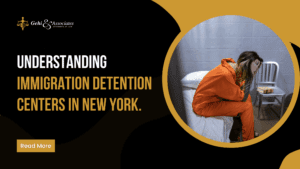Thousands of individuals in need of detention attorneys are held in civil immigration detention centers throughout the state each year. These centers are operated under the oversight of U.S. Immigration and Customs Enforcement (ICE). They function with a complex blend of federal enforcement, private contracting, and shifting local policies.
Immigration detention is not criminal incarceration in legal terms, but the experience for detainees is often indistinguishable. The system is large, unclear, and deeply consequential. Understanding what happens behind the barbed wire is essential for families, advocates, and policymakers. In New York, detainees can be held for days, weeks, or even years while handling the complex legal system.
Detention isn’t about punishment. It’s about securing an immigrant’s presence for proceedings. However, the consequences for human health, dignity, and due process are anything but neutral. The average detained person faces an uphill legal battle with limited access to counsel, medical care, or basic information. Qualified detention attorneys provide guidance on how detention works, who gets held, and what happens inside.
Key Statistics:
- ICE’s average daily detained population (ADP) reached over 47,800 as of March 2025.
- The average length of stay in ICE custody nationwide is approximately 52 days.
- Between October 2024 and May 2025, at least 10 individuals died in ICE detention nationwide.
- ICE resumed family detention in April 2025 after suspending the practice in 2022.
- ICE currently holds detainees in over 100 facilities across multiple states, including New York.
- Nearly 90% of immigrants in ICE custody are held in privately operated facilities.
Why You Need a Detention Attorney in New York?
Immigration detention in New York is part of a sprawling civil enforcement system. It is controlled by U.S. Immigration and Customs Enforcement (ICE). Though labeled “civil,” the structure and practices of immigration detention often mimic criminal incarceration. From limited movement to restricted access to medical care, the lived reality for detainees blurs legal lines. This is where a skilled detention attorney in New York offers experience, cultural awareness, and strategic defense.
Custody Determination
Detention begins with ICE’s custody decision. Some individuals must be held under mandatory detention laws. Particularly those with aggravated felony convictions or repeat immigration violations. Others fall into discretionary detention, where ICE considers factors like flight risk or potential danger to the public. The system often errs on the side of detention, even when legal relief is available.
Agents make initial determinations using criminal history, asylum claims, and biometric data. They rely heavily on the Risk Classification Assessment (RCA), which has been criticized for recommending detention in most cases. A detention attorney can request a bond hearing before an immigration judge or pursue parole based on humanitarian grounds.
Types of Facilities in Use
New York holds detainees in a network of public and private facilities, often far from their communities. ICE contracts with jails under Intergovernmental Service Agreements (IGSAs) or with corporations. Each facility must follow one of ICE’s detention standards. Performance-Based National Detention Standards (PBNDS) 2011 or National Detention Standards (NDS) 2019. The standard used depends on contract type, not detainee needs. For example:
- PBNDS 2011 offers more protections, including LGBTQ+ safeguards and improved medical access.
- NDS 2019 is used more frequently in county jails. It often results in harsher conditions.
Detention attorneys often challenge facility transfers or inadequate access to counsel based on violations of these standards. Without legal intervention, detainees risk being sent to remote jails that delay hearings and isolate them from support networks. A Queens-based detention attorney can pressure ICE to keep clients in-state or near family support.
Detention Length and Transfers
ICE’s data shows the average stay in detention nationwide is around 52 days. However, the average stay is far longer for New York residents seeking legal relief, such as asylum. Transfers between facilities worsen the situation. ICE can move detainees without notice, sometimes across state lines. This breaks attorney-client relationships, stalls legal filings, and blocks access to case files or healthcare. Transfer decisions often happen overnight, with no time for families to respond.
Detention attorneys act fast to file stay motions and oppose transfers. They also file release requests under ICE’s post-order custody review process, especially for detainees held past 90 days without removal. Without legal representation, many immigrants spend months longer in custody than necessary.
Alternatives to Detention (ATD)
ICE offers several alternatives to detention, but not often in New York. These include GPS ankle monitors, phone check-ins via SmartLINK, and in-person reporting. While these programs are cheaper and less punitive, ICE uses them sparingly, especially in cases labeled “high priority.” Detainees often qualify for ATD based on:
- Nonviolent history
- Strong community ties
- Ongoing legal case or asylum application
- Medical or mental health needs
A detention attorney can compile documentation that supports ATD placement and submit a parole request to ICE ERO. In many cases, ICE fails to offer alternatives unless formally requested. Families in Queens benefit from local attorneys who can frame a strong ATD case. They use affidavits, employment letters, and medical evidence.
A qualified detention attorney provides critical services:
- Requests custody redetermination hearings
- Files bond motions backed by evidence of stability
- Opposes unlawful ICE transfers
- Documents medical neglect for humanitarian parole
- Prepares asylum, cancellation, or adjustment petitions.
Queens Immigration Attorney offers representation that reflects cultural understanding that can transform outcomes. just read any recent client review to see the difference they’ve made, especially for Bengali, Nepali, Arabic-speaking, or Haitian communities.
How Do Conditions Inside New York Immigration Detention Centers Compare to State Prisons or Jails?
ICE detention does not serve as punishment. However, it enforces similar restrictions: locked cells, limited movement, and strict control over communication, visitation, and healthcare. Detainees often experience harsher conditions than convicted criminals, despite lacking a criminal conviction.
Standards and Oversight in Theory
ICE facilities are required to follow detention standards like PBNDS 2011 or NDS 2019, but oversight is inconsistent. These standards outline everything from suicide prevention to food safety. In practice, even facilities rated as “Meets Standards” fail to protect detainees. ICE’s records show that routine inspections often miss dangerous conditions. For example, several facilities received passing grades despite open violations of health and safety regulations. These include underreported use-of-force incidents and sanitation failures.
Solitary Confinement and Isolation
ICE insists that segregation in detention is nonpunitive. However, the real-world application of solitary confinement tells another story. Detainees placed in “Special Management Units” (SMUs) often face 22–23 hours a day in isolation. This includes those with diagnosed mental illness who are deemed “vulnerable.” Detention attorneys can file writs or federal complaints on behalf of clients suffering in solitary.
Food, Hygiene, and Daily Life
ICE detention often lacks the basic daily structure found in New York correctional facilities. Many detainees report unsanitary bathrooms, poor ventilation, and minimal access to exercise. Meals frequently lack nutritional value and cater poorly to medical or religious diets. Unlike prisons, where inmates have job programs or educational access, ICE detainees spend their days idle and uncertain. Without legal pressure, conditions rarely improve. Attorneys can highlight living condition failures as part of parole or bond filings.
Legal Access and Visitation
Unlike state prisons, immigration detention centers often obstruct access to counsel. ICE provides no right to government-funded representation. Facilities frequently lack enough attorney-client visitation rooms or limit phone access through long waitlists or dropped calls. Detention Attorneys intervene by demanding prompt legal access and challenging unreasonable communication barriers.
How does Length of Stay for Detainees Vary by Nationality or Legal Status?
Immigration detention in New York often means months of waiting, uncertainty, and legal stagnation. ICE claims to manage detention efficiently. However, the actual time many individuals spend in custody far exceeds national averages. These prolonged detentions carry mental, emotional, and legal consequences that worsen with time.
National Averages vs. New York Reality
Nationally, ICE reports an average detention stay of about 52 days. However, this number tells only part of the story. That figure includes individuals deported quickly or held briefly at the border. In contrast, many detained immigrants in New York are seeking relief like asylum, cancellation of removal, or withholding of removal. These cases take far longer to resolve. Delays extend when ICE transfers detainees between facilities, as is common in upstate New York and New Jersey.
Impact of Legal Status
Legal status shapes the timeline in ICE custody. Immigrants with prior removal orders, recent visa overstays, or criminal convictions tend to face quicker processing. But those with pending relief applications, especially asylum seekers, often remain in detention much longer. Legal status determines whether individuals are eligible for parole, bond, or expedited removal.
Variations by Nationality
Detainee nationality significantly influences detention length. For example, Mexican and Central American nationals are often repatriated faster due to established removal protocols. Especially from Honduras, El Salvador, and Guatemala. In contrast, individuals from Cameroon, Venezuela, or China face much longer stays. These delays stem from several factors:
- Lack of travel documents: Some home countries delay or deny repatriation paperwork.
- Ongoing conflict: ICE cannot deport individuals to war zones or unstable governments.
- Temporary Protected Status (TPS): Individuals from TPS-designated countries may qualify for deferred action.
Looking for trusted legal help? Meet the top immigration attorneys in Queens who deliver results
FAQs
Who Is Held in Detention Centers? People held in ICE detention include asylum seekers, undocumented individuals, visa overstayers, and those with criminal records. Some are held mandatorily; others are evaluated for flight or safety risk. Many have never been convicted of a crime. Legal help can help change the trajectory of their cases.
How Does Immigration Detention Work? Detention begins with ICE custody and an initial custody review. Based on the threat level, ICE decides between detention, ATD, or release. Detention is civil, but its conditions often resemble jail. A skilled attorney can challenge the initial custody decision.
What to Do If Detained at the Airport? Ask for an attorney immediately and avoid signing anything without understanding it. If you fear returning to your country, express that clearly. U.S. ports of entry fall under federal jurisdiction, so local representation matters. Attorneys in Queens know how to act quickly.
What Is the Difference Between a Detention Center and a Jail? A detention center holds individuals for civil immigration violations. A jail is for criminal detention. However, conditions can be identical, and some facilities even serve both functions. That’s why legal representation is critical for any detainee.
Who Operates Detention Centers? ICE contracts with a mix of federal, state, and private facilities. Oversight varies greatly by facility and operator. Attorneys provide external pressure when oversight fails internally.
How to Check If Someone Is Detained by Immigration? Use the ICE Online Detainee Locator System. You’ll need the person’s A-number or biographical info. A detention attorney can assist if the system shows no results or if you suspect a transfer. Timing is crucial, especially after arrest.
Get Help from a Queens Detention Attorney
Immigration detention in New York is a complex, bureaucratic, and often devastating system. A skilled detention attorney in Queens can assess the risk, challenge the detention, and fight for release through bond, parole, or legal relief. People don’t just lose time in detention; they lose stability and family connections. At Queens Immigration Attorney, we push back against unjust classifications, argue for medical releases, and give families a voice. Book a free consultation today!





